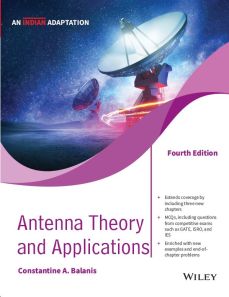Antenna Theory and Applications, 4ed (An Indian Adaptation)
ISBN: 9789354248474
976 pages
For more information write to us at: acadmktg@wiley.com

Description
Antenna Theory and Applications is a classical textbook in the field, which introduces the fundamental principles of antenna theory and explains how to apply them to the analysis, design, and measurements of antennas. Due to the variety of methods of analysis and design, and the different antenna structures available, the applications covered in this book are made to some of the most basic and practical antenna configurations. Among these antenna configurations are linear dipoles, loops, arrays, broadband antennas, aperture antennas, horns, microstrip antennas, and reflector antennas.
1 Introduction To Antennas
1.1 Introduction
1.2 Types of Antennas
1.3 Radiation Mechanism
1.4 Current Distribution on a Thin Wire Antenna
1.5 Historical Advancement
2 Fundamental Parameters And Figure-Of-Merit Of Antennas
2.1 Introduction
2.2 Radiation Pattern
2.3 Radiation Power Density
2.4 Radiation Intensity
2.5 Beamwidth
2.6 Directivity
2.7 Numerical Techniques
2.8 Antenna Efficiency
2.9 Gain, Realized Gain
2.10 Beam Efficiency
2.11 Bandwidth
2.12 Polarization
2.13 Input Impedance
2.14 Antenna Radiation Efficiency
2.15 Antenna Vector Effective Length and Equivalent Areas
2.16 Maximum Directivity and Maximum Effective Area
2.17 Friis Transmission Equation and Radar Range Equation
2.18 Antenna Temperature
3 Radiation Integrals And Auxiliary Potential Functions
3.1 Introduction
3.2 The Vector Potential A for an Electric Current Source J
3.3 The Vector Potential F for a Magnetic Current Source M
3.4 Electric and Magnetic Fields for Electric (J) and Magnetic (M) Current Sources
3.5 Solution of the Inhomogeneous Vector Potential Wave Equation
3.6 Far-Field Radiation
3.7 Duality Theorem
3.8 Reciprocity and Reaction Theorems
4 Linear Wire And Loop Antennas
4.1 Introduction
4.2 Infinitesimal Dipole
4.3 Small Dipole
4.4 Region Separation
4.5 Finite Length Dipole
4.6 Half-Wavelength Dipole
4.7 Linear Elements Near or On Infinite Perfect Electric Conductors (PEC), Perfect Magnetic Conductors (PMC) and Electromagnetic Band-Gap (EBG) Surfaces
4.8 Ground Effects
4.9 Loop Antennas
4.10 Small Circular Loop
4.11 Arrays
4.12 Mobile Communication Systems Applications
5 Aperture Antennas
5.1 Introduction
5.2 Field Equivalence Principle: Huygens’ Principle
5.3 Radiation Equations
5.4 Directivity
5.5 Rectangular Apertures
5.6 Circular Apertures
5.7 Babinet’s Principle
5.8 Fourier Transforms in Aperture Antenna Theory
5.9 Ground Plane Edge Effects: The Geometrical Theory of Diffraction
6 Horn Antennas
6.1 Introduction
6.2 E-Plane Sectoral Horn
6.3 H-Plane Sectoral Horn
6.4 Pyramidal Horn
6.5 Conical Horn
6.6 Corrugated Horn
6.7 Multimode Horns
6.8 Dielectric-Loaded Horns
6.9 Phase Center
7 Reflector Antennas
7.1 Introduction
7.2 Plane Reflector
7.3 Corner Reflector
7.4 Parabolic Reflector
7.5 Spherical Reflector
8 Planar And Microstrip Antennas
8.1 Introduction
8.2 Rectangular Patch
8.3 Circular Patch
8.4 Quality Factor, Bandwidth, and Efficiency
8.5 Input Impedance
8.6 Coupling
8.7 Circular Polarization
9 Traveling Wave And Broadband Antennas
9.1 Introduction
9.2 Traveling Wave Antennas
9.3 Broadband Antennas
9.4 Frequency Independent Antennas
9.5 Equiangular Spiral Antennas
9.6 Log-Periodic Antennas
9.7 Fundamental Limits of Electrically Small Antennas
9.8 Antenna Miniaturization
9.9 Fractal Antennas
10 Broadband Dipoles And Matching Techniques
10.1 Introduction
10.2 Biconical Antenna
10.3 Triangular Sheet, Flexible and Conformal Bow-Tie, and Wire Simulation
10.4 Vivaldi Antenna
10.5 Cylindrical Dipole
10.6 Folded Dipole
10.7 Discone and Conical Skirt Monopole
10.8 Matching Techniques
11 Arrays: Linear, Planar, And DipolE
11.1 Introduction
11.2 Two-Element Array
11.3 N-Element Linear Array: Uniform Amplitude and Spacing
11.4 N-Element Linear Array: Directivity
11.5 Design Procedure
11.6 N-Element Linear Array: Uniform Spacing, Nonuniform Amplitude
11.7 Superdirectivity
11.8 Planar Array
11.9 Design Considerations
11.10 Dipole Array
11.11 Design of Dipole Array
11.12 Mutual Coupling in Arrays
11.13 Arrays and Feed Networks
12 Modern Antenna Structures
12.1 Introduction
12.2 Reconfigurable Antennas
12.3 Ultra Wideband (UWB) Antennas
12.4 Metamaterials Based Antennas
12.5 Dielectric Resonator Antennas
12.6 Substrate-Integrated Waveguide (SIW) Antennas
12.7 Wearable Textile Antennas
12.8 Smart Antennas
13 Antenna Measurements
13.1 Introduction
13.2 Antenna Ranges
13.3 Radiation Patterns
13.4 Gain Measurements
13.5 Directivity Measurements
13.6 Radiation Efficiency
13.7 Impedance Measurements
13.8 Current Measurements
13.9 Polarization Measurements
13.10 Scale Model Measurements
14 Applications Based Antennas
14.1 Introduction
14.2 Frequency Band Allocation for Various Applications
14.3 Antennas for Mobile Communications
14.4 Antennas for Satellite Communications
14.5 Antennas for Navigation Purposes
14.6 Antennas for Radar and Remote Sensing Applications
14.7 Antennas for Bluetooth Applications
14.8 Antennas for Wi-Fi Applications
14.9 Antennas for Automobile Applications
14.10 Antennas for Defense Applications
14.11 Antennas for Biomedical Applications
14.12 Antennas for Tera Hertz Applications
14.13 Concluding Remarks
15 Advanced Microwave Communication And Wave Propagation
15.1 Introduction
15.2 Atmospheric Layers and Modes of Propagation
15.3 Ground Wave Propagation
15.4 Surface Wave Propagation
15.5 Space Wave Propagation
15.6 Ionospheric Wave Propagation
15.7 Smart-Antenna Analogy
15.8 Cellular Radio Systems Evolution
15.9 Signal Propagation
References
Problems
Appendices

